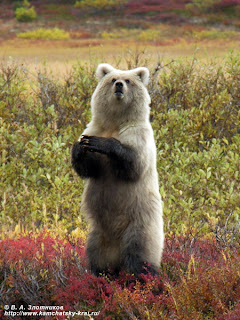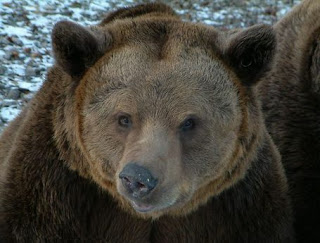Order Carnivora : Family
Ursidae : Ursus arctos Linnaeus
 Description
DescriptionLargest of the carnivores in western United States; head large with face distinctly "dished in"; body robust; legs strong, massive, and relatively short; tail much shorter than hind foot; last upper molar about as large as the two teeth in front of it combined; front claws 7-12 cm in length; upperparts brownish or yellowish brown, often with inter-mixture of white-tipped hairs; underparts similar to upperparts but lacking white-tipped hairs. Dental formula as in the black bear. External measurements of adult male: total length, 1,982 mm; length of tail, 76 mm; hind foot, 280 mm; height at shoulder, 1,017 mm. Females smaller. Weight of males, 180-360 kg, seldom as much as 500 kg; females, 130-180 kg, seldom as much as 360 kg.
Distribution
Only two specimens of grizzly bears are available from Texas. According to Vernon Bailey, who wrote of this bear in his "Biological Survey of Texas," a large and very old male
 grizzly was killed in the Davis Mountains in October, 1890 by C. O. Finley and John Z. Means. Measurements of the skull are: greatest length, 370 mm; basal length, 310 mm; zygomatic breadth, 220 mm; mastoid breadth, 157 mm; interorbital breadth, 71 mm; postorbital breadth, 69 mm. Mr. Finley reported that the claws on the front feet were about 31/2 inches (9 cm) long, and the color of the bear was brown with gray tips to the hairs. Its weight was estimated at 1,100 pounds (500 kg) "if it had been fat." Mr. Finley found that this bear had killed a cow and eaten most of it in a gulch near the head of Limpia Creek, where the dogs took the trail. Out of a pack of 52 hounds, only a few would follow the trail, although most of them were used to hunting black bear. These few followed rather reluctantly, and after a run of about 8 km over rough country stopped the bear, which killed one of them before it was quieted by the rifles of Finley and Means. It took four men to put the skin, with head and feet attached, upon a horse for the return to camp.
grizzly was killed in the Davis Mountains in October, 1890 by C. O. Finley and John Z. Means. Measurements of the skull are: greatest length, 370 mm; basal length, 310 mm; zygomatic breadth, 220 mm; mastoid breadth, 157 mm; interorbital breadth, 71 mm; postorbital breadth, 69 mm. Mr. Finley reported that the claws on the front feet were about 31/2 inches (9 cm) long, and the color of the bear was brown with gray tips to the hairs. Its weight was estimated at 1,100 pounds (500 kg) "if it had been fat." Mr. Finley found that this bear had killed a cow and eaten most of it in a gulch near the head of Limpia Creek, where the dogs took the trail. Out of a pack of 52 hounds, only a few would follow the trail, although most of them were used to hunting black bear. These few followed rather reluctantly, and after a run of about 8 km over rough country stopped the bear, which killed one of them before it was quieted by the rifles of Finley and Means. It took four men to put the skin, with head and feet attached, upon a horse for the return to camp.Walter Dalquest reported examining the partial skull of a grizzly bear that had washed out on the banks of the Red River (Montague County) about 1950. This specimen has since been lost.
 Habits
HabitsThe grizzly is essentially an inhabitant of rough, mountainous country today, but considerable evidence points to the fact that 100 years ago it was also very much at home in the plains of the West. The impact of contact with the white man has forced the grizzly to make his last stand in rough, wilderness terrain.
The home range of grizzlies is estimated to be about 40 km in diameter in regions where food is plentiful. On the Sun River Game Preserve in Montana, on which no hunting has been permitted since 1912, the population averages one grizzly to 28 km² of range. This figure probably is close to the maximum population density attained before the white man settled the West. Outside the preserve, the population density is about one-third as great, because of hunting pressure, and in many sections of the state the grizzly has long been extinct.
 Like the black bear, the grizzly holes up and sleeps through the severe part of the winter, subsisting on fat stored in the body. It does not hibernate in the true sense of the word. The young are born while the mother is in her winter den.
Like the black bear, the grizzly holes up and sleeps through the severe part of the winter, subsisting on fat stored in the body. It does not hibernate in the true sense of the word. The young are born while the mother is in her winter den.The natural food of grizzlies is extremely varied. Results of a study made in Montana revealed the following: early spring: winter-killed animals, green grasses, and weeds; middle and late spring: bulbs and roots, increasing use of grasses and sedges, few rodents, occasional young elk calves; summer: continued use of green vegetation, ants, beetles, and other insects, fruits and berries, few rodents; fall: largely pine nuts, few rodents. In certain sections they feed extensively on salmon during the spring run; occasional individuals turn renegade and become killers of livestock.
 The breeding season is in June and July, and from one to four cubs (usually two) are born 6 or 7 months later. Seton gives the gestation period as 180-187 days; Brown, 236 days. The young cubs weigh about 750 g at birth, are about 20 cm long, and their eyes and ears are closed. Their eyes open in 8 or 9 days, in contrast to 6 weeks in the black bear.
The breeding season is in June and July, and from one to four cubs (usually two) are born 6 or 7 months later. Seton gives the gestation period as 180-187 days; Brown, 236 days. The young cubs weigh about 750 g at birth, are about 20 cm long, and their eyes and ears are closed. Their eyes open in 8 or 9 days, in contrast to 6 weeks in the black bear.
No comments:
Post a Comment